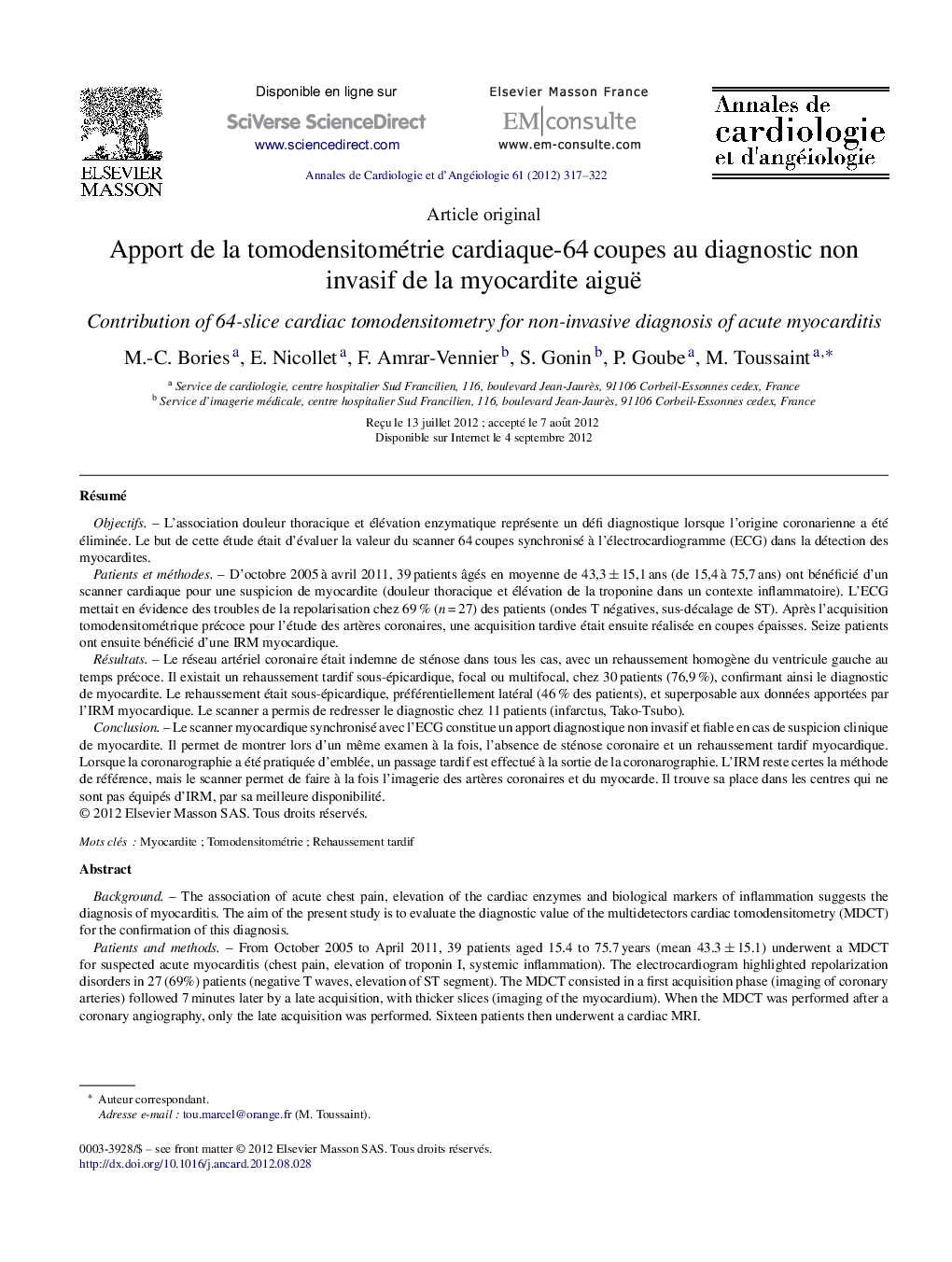| Article ID | Journal | Published Year | Pages | File Type |
|---|---|---|---|---|
| 2868866 | Annales de Cardiologie et d'Angéiologie | 2012 | 6 Pages |
RésuméObjectifsL’association douleur thoracique et élévation enzymatique représente un défi diagnostique lorsque l’origine coronarienne a été éliminée. Le but de cette étude était d’évaluer la valeur du scanner 64 coupes synchronisé à l’électrocardiogramme (ECG) dans la détection des myocardites.Patients et méthodesD’octobre 2005 à avril 2011, 39 patients âgés en moyenne de 43,3 ± 15,1 ans (de 15,4 à 75,7 ans) ont bénéficié d’un scanner cardiaque pour une suspicion de myocardite (douleur thoracique et élévation de la troponine dans un contexte inflammatoire). L’ECG mettait en évidence des troubles de la repolarisation chez 69 % (n = 27) des patients (ondes T négatives, sus-décalage de ST). Après l’acquisition tomodensitométrique précoce pour l’étude des artères coronaires, une acquisition tardive était ensuite réalisée en coupes épaisses. Seize patients ont ensuite bénéficié d’une IRM myocardique.RésultatsLe réseau artériel coronaire était indemne de sténose dans tous les cas, avec un rehaussement homogène du ventricule gauche au temps précoce. Il existait un rehaussement tardif sous-épicardique, focal ou multifocal, chez 30 patients (76,9 %), confirmant ainsi le diagnostic de myocardite. Le rehaussement était sous-épicardique, préférentiellement latéral (46 % des patients), et superposable aux données apportées par l’IRM myocardique. Le scanner a permis de redresser le diagnostic chez 11 patients (infarctus, Tako-Tsubo).ConclusionLe scanner myocardique synchronisé avec l’ECG constitue un apport diagnostique non invasif et fiable en cas de suspicion clinique de myocardite. Il permet de montrer lors d’un même examen à la fois, l’absence de sténose coronaire et un rehaussement tardif myocardique. Lorsque la coronarographie a été pratiquée d’emblée, un passage tardif est effectué à la sortie de la coronarographie. L’IRM reste certes la méthode de référence, mais le scanner permet de faire à la fois l’imagerie des artères coronaires et du myocarde. Il trouve sa place dans les centres qui ne sont pas équipés d’IRM, par sa meilleure disponibilité.
BackgroundThe association of acute chest pain, elevation of the cardiac enzymes and biological markers of inflammation suggests the diagnosis of myocarditis. The aim of the present study is to evaluate the diagnostic value of the multidetectors cardiac tomodensitometry (MDCT) for the confirmation of this diagnosis.Patients and methodsFrom October 2005 to April 2011, 39 patients aged 15.4 to 75.7 years (mean 43.3 ± 15.1) underwent a MDCT for suspected acute myocarditis (chest pain, elevation of troponin I, systemic inflammation). The electrocardiogram highlighted repolarization disorders in 27 (69%) patients (negative T waves, elevation of ST segment). The MDCT consisted in a first acquisition phase (imaging of coronary arteries) followed 7 minutes later by a late acquisition, with thicker slices (imaging of the myocardium). When the MDCT was performed after a coronary angiography, only the late acquisition was performed. Sixteen patients then underwent a cardiac MRI.ResultsNo significant coronary stenoses were found in all patients. The MDCT showed homogeneous myocardial enhancement on the early acquisition. A subepicardial late enhancement was found in 30 (76.9%) patients. The subepicardial enhancement was mainly found in the lateral myocardium. In patients who underwent cardiac MRI and MDCT (n = 16), there was a good correlation between the enhanced segments. MDCT found differential diagnosis in 11 patients (myocardial infarction, Tako-Tsubo).ConclusionThe ECG-gated MDCT is a non-invasive and reliable diagnostic tool in patient with suspected myocarditis. It allows at the same time to rule out a significant coronary disease, when no coronary angiography was performed, and to show subepicardial enhancement confirming the diagnosis of myocarditis. While cardiac MRI remains the gold standard, MDCT could prove useful when there is no access to or contraindication for an MRI, studying both the coronary arteries and the myocardium.
